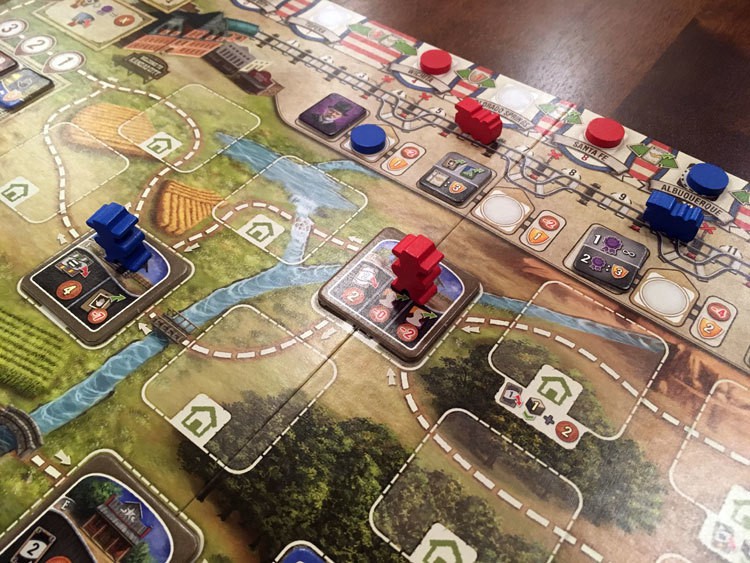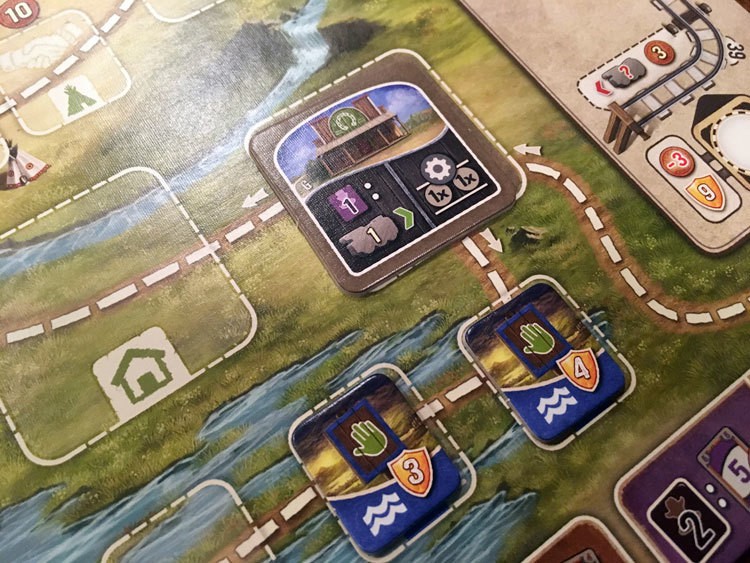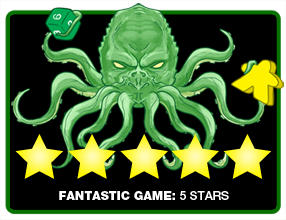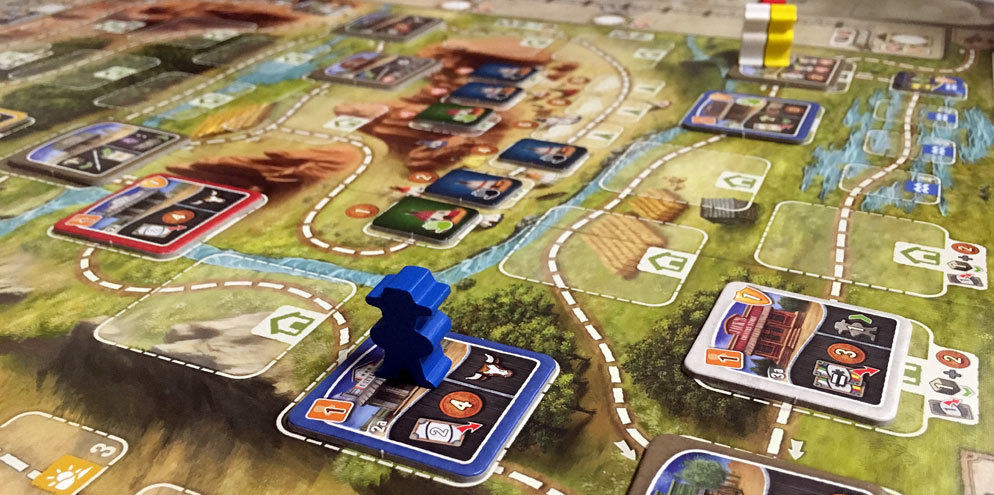 Having grown up in Texas, this reviewer knows well the connection between people, cattle country, and the history of drives north to feed the growing affluence of the west coast and northeast. Texas is a land of multiple types of terrain, big skies, and sunsets. The land often speaks to you in the thunderstorms and floods of the southeast or the wide emptiness in the panhandle or southwest desert.
Having grown up in Texas, this reviewer knows well the connection between people, cattle country, and the history of drives north to feed the growing affluence of the west coast and northeast. Texas is a land of multiple types of terrain, big skies, and sunsets. The land often speaks to you in the thunderstorms and floods of the southeast or the wide emptiness in the panhandle or southwest desert.
With the theme of driving cattle to market in Kansas City, a new game from Eggertspiele and Alexander Pfister of Spiel des Jahres fame delivers a game subtly out of the ordinary. These are two names known for standing behind some great games. However, will the combination deliver another great game? Or will the high expectations end up with a game that’s just a lot of bull?
Great Western Trail is a hand management, action selection, and strategic movement game for 2-4 players that takes about 75-150 min to play. A first play is best with 2 players, but later games are more exciting with 3-4 players.
Game Overview:
Players taking on Great Western Trail will find themselves running a cattle empire seeking to deliver the best herds of cattle to markets in Kansas City. They do so by directing a cowboy along a winding path through hazardous terrain, Native American villages, and way stations, which may or may not be helpful. The player who manages to make the most points from a wide variety of activities in that endeavor is the winner.
Game Components:

The specific components of Great Western Trail are utilitarian. Cardboard building tiles, cardboard coins, cowboy meeples, train meeples, various cards, and other wooden components are all of decent quality but nothing stands out as a bit worthy of notice. The included player boards could have been thicker cardboard, but otherwise the pieces are fine.
What is noticeable is the art and graphic design. Andreas Resch, the illustrator and graphic designer, has done an amazing job distilling many complex game actions into icons. The language of the icons, regions of the player boards, and main board need explanation, but quickly during a first play, the visual reference is ingrained. This is an impressive feat and although an icon reference was something missed when playing for a first time, after that play, the need dissipates drastically.
How to Play:
A setup for Great Western Trail has players seeding the board in a couple of different ways. Neutral buildings (grey borders) are either placed in sequence for the beginner setup or randomly placed in predetermined locations for the advanced setup. Employee tiles are placed on a track based on the number of players. This also serves as a game timer. The game time is not based on player rounds, but rather how many times players reach Kansas City.
Players prepare their personal boards, a cowboy and train meeple are placed at start locations, and players draw a hand of cattle cards to complete setup.
Each player turn is composed of three parts, unimaginatively called Phase A, B, and C.
Phase A – Cowboy Movement

During this phase, a player decides how many spaces to move their cowboy forward. At the beginning of the game, this could be 3 or 4 spaces. After upgrades are taken, this could be as fast as 7 spaces. The space a player chooses to end on will determine the actions available to that player. Also, if a player moves over any hazards, native tipis, or opposing player spaces with a hand symbol, they must pay in coins for the movement.
Phase B – Actions/Delivery
If a player lands on their own building or a neutral building, they can take the actions of that building or they can choose to do some minor actions (auxiliary actions). Building actions usually involve manipulating cattle cards in hand, moving the train, hiring employees, or purchasing cattle.
If a player reaches Kansas City, the employee hiring spaces are replenished and new hazards or tipis can come out on the board. After that, a player reveals their hand of cattle cards. For each unique card, a player adds the card’s value to their total breeding value. This determines how much money a player receives and how far they can deliver their cattle. For example, if a player’s breeding value is 10, they can deliver their cattle as far as Albuquerque (the 10 space). However, if the player’s train has not reached Albuquerque, they must pay extra. These cattle cards are then discarded.
A disc from the player’s board is then placed on the location they have delivered to. As these discs are taken from player boards, they receive the revealed upgrade during future turns. After this, the player positions their cowboy back at the trail start space.
Phase C – Refill
Finally, if a player has fewer than their hand limit in cards, they refill to their hand limit.
This description above is a very quick and high level overview of the rules. For more specifics, you can download a PDF of the rulebook that presents the full depth of all the additional game mechanisms and detail of all the available actions.

Game Experience:
When sitting down at a game table, players about to play Great Western Trail will quickly begin to realize how complex the game is, but how simple the core mechanism of a turn is. This seems to be a hallmark of many Alexander Pfister games. This concept forms the backbone of reviewing his work as well. It is precisely the creativity in delivering complex play in simpler processes that makes for the bulk of the enjoyment. There is a lot of content to learn, but it’s not overwhelming and players can get to the enjoyment quickly.
Players who enjoy complex strategic puzzles like this will be in heaven. Great Western Trail has quite a few levers to turn and a hand of cattle to wrangle to boot. Even though downtime in the game is minor, there’s just so much to consider during that time that players will never have a moment to be distracted.
The central strategy of Great Western Trail is optimizing choices along a route with the aim of increasing the value of your delivery and position on the train track to help make future deliveries. There are also a variety of additional points to be gained along the way which players have to decide if they want to slow down for.

Since players will receive points at the end of the game for cattle cards, deliveries, people, and buildings, there are a variety of strategies to consider and upgrades to choose. It’s even possible to focus primarily on progressing on the train track to gain points from building stations. The term “point salad” will undoubtedly come up from experienced gamers and this experience fits that to a T.
The primary interaction in the game comes from adding buildings and hazards to the board or competing for purchases of employees or cattle. There are also objective cards that provide additional points at the end of the game. Even though much of this interaction is passive, players are constantly affecting how the game environment evolves and opportunities available to other players.
For players who loathe direct conflict (something which was more prevalent in Mombasa), Great Western Trail always offers a choice. Each player determines their cowboy’s pace and path. Unless another player has locked up certain routes, players are more often forcing hard choices on others rather than causing opponents to lose resources.
The other type of complex puzzle enjoyment comes from players crafting a set of stopping points on their way to Kansas City that, by virtue of their placement and function, form a game engine. Opponent building placements will throw a wrench in the works if players do not have enough movement. Choosing the right placement of a building so that a cowboy has stopping options is also important. There is so much strategy involved in this aspect of the game, and it’s amazing to experience, especially in higher player count games.
The variety of play is another aspect where this game hits the high notes. A preliminary play with the basic neutral building locations and all the “A” side player buildings will seem complex at first, but the type and location of each neutral buildings is by design introductory. Once these buildings have their locations randomized, a whole new set of challenges arises around how and when to spend money. When you couple that with the variety of buildings from the A to the B side and you’ve got an extremely high number of game variables to experience.

With all of this complexity, one would assume that play is difficult to teach. It is not. The basics of play are simple, but it is the options and the importance of systems which must be pondered upon. Each mechanism of the game makes sense once explained and their interaction is the root engagement for players. It is often difficult for games to get this right, but Great Western Trail handles everything beautifully.
The negatives of Great Western Trail are outside cases and do not pose impediments to play. If players commonly use the neutral buildings in the basic locations from game to game, the overall patterns of play and strategies will feel repetitive. Additionally, the functions of a couple buildings (the ones on the upper end of the price scale) are obtuse, but as these rarely come out, it needs little more than an explanation once implemented for players to understand the strategy. Finally, a first play of Great Western Trail is a LONG ride, clocking in at nearly double the expected play time. This is due mainly to players comprehending the iconography and aspects of strategy understanding each subsystem.
Final Thoughts:
Great Western Trail is an amazing game. It deviates from traditional heavy strategy game patterns such as managing an economic empire or developing a company or country. The simplistic nature of moving a herd (hand) of cattle and making the best choices along the way is an uncommon economic engine, but player engagement and strategic choices are heavily layered into every action. This makes it an immensely fun experience with every play.
For heavy strategy gamers, this will be a gem. Great Western Trail delights with multiple paths to victory and a theme that throws another curve into the heavy Euro genre. To answer the leading questing, all high expectations have been met from Eggertspiele and Alexander Pfister once again. Be sure to watch the Kennerspiel des Jahres nominations for his name once again.
If you’d like to pick up a copy of Great Western Trail, you can get it for about $60.
Final Score: 5 Stars – Heavy choices based around a simple movement mechanism deliver variety and intense strategy with every play.
 Hits
Hits
• Several strategic levers
• Tactical choices that change as the game evolves
• Player decisions are deeply impactful
• Play style changes dramatically based on building setup
Misses:
• Repetitive play style with the basic setup
• Long first play
























Great Game! Only problem I see is that you have to specialize in order to win.
This is not always true. In a recent game. I diversified across all scoring categories to pull out a surprising win against two formidable players, one focusing on Engineers planting his tokens on the extreme stations, the other focusing on craftsmen erecting the big ticket buildings. Admittedly, it does require to adapt (as any good game does) and make sure your opponents are not able to have the ultra-scoring opportunities that blends with their focus. But you should be able to see that from afar and appropriately plan.
We are probably still in the learning phase – I’ve seen a balanced approach win too. Might not work against veteran experienced players.
This is a very good game, and will really appeal to lovers of heavy Euros. I would warn people though that there is no catch-up mechanic in the game. Combined with a low amount of chance, you’ll tend to see people streak ahead especially if they get a good start. New players will also be slaughtered!
I did notice this, but I haven’t seen the lack of any significant catch up mechanic seriously annoy players. Often you don’t specifically know the relative positions of players in points except for doing mental math, remembering the cow cards and other points players have collected.
Is this connected to Carson City in any way?
No. Not as such.